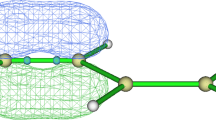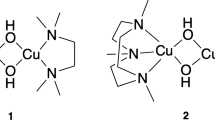Abstract
The electron density of the [(μ3-S) Fe3(CO)9(μ3-CO)] cluster was analyzed using the quantum theory of atoms in molecules (QTAIM) to explore its topological properties. This analysis provides valuable insight into the interactions between Fe–Fe, Fe–C, and Fe–S as well as other important topological properties of the compounds. Analysis of the core part, especially the S–Fe3–CO region, does not show the presence of bcp (bonding critical points) and bp (bonding pathways) for any pair of M–M (metal–metal) bonds, indicating significant delocalization. There may be multicentric (5c–4e) interactions in the central region of the junction. Examining topological data for Fe–Fe, Fe–S, and Fe–CO bonds, we find that all of these bonds exhibit typical properties of closed-shell metal–metal interactions. However, there is evidence that there is an actual chemical bond between the Fe metal and the carbon atoms of the CO ligand, rather than just an “interaction.” The presence of sulfide-bridging ligands plays an important role in effectively reducing the delocalization of electron density between sulfide-bridged iron pairs as opposed to iron pairs that are not bridging and are coordinated by carbonyl ligands.




Similar content being viewed by others
Availability of data and materials
The authors confirm that the data supporting the findings of this study are available within the article.
References
Gatti C (2005) Chemical bonding in crystals: new directions. Zeitschrift für Kristallographie Crystal Mater 220(5–6):399–457
Čanović P et al (2017) Impact of aromaticity on anticancer activity of polypyridyl ruthenium (II) complexes: synthesis, structure, DNA/protein binding, lipophilicity and anticancer activity. J Biol Inorg Chem 22:1007–1028
Kameo H, Shima T, Nakajima Y, Suzuki H (2009) Synthesis of heterometallic trinuclear polyhydrido clusters containing ruthenium and osmium and their electronic and structural deviation from homometallic systems. Organometallics 28(8):2535–2545
Kameo H, Suzuki H (2008) Synthesis of trinuclear osmium polyhydrido clusters [{(C5Me5) Os}3(μ-H)6]+ and (C5Me5) Os3(μ-H)3(μ3-H)2 and comparison with the ruthenium analogues. Organometallics 27(16):4248–4253
Nakajima Y, Kameo H, Suzuki H (2006) Cleavage of nitrogen–hydrogen bonds of ammonia induced by triruthenium polyhydrido clusters. Angew Chem 118(6):964–966
Kameo H, Nakajima Y, Namura K, Suzuki H (2011) Heterometallic effects in nitrogen–hydrogen bond cleavage by trinuclear mixed-metal polyhydrido clusters containing ruthenium and osmium. Organometallics 30(24):6703–6712
Bader RF (1991) A quantum theory of molecular structure and its applications. Chem Rev 91(5):893–928
Cabeza JA, Van der Maelen JF, Garcia-Granda S (2009) Topological analysis of the electron density in the N-heterocyclic carbene triruthenium cluster [Ru3 (μ-H)2 (μ3-MeImCH)(CO)9](Me2Im = 1,3-dimethylimidazol-2-ylidene). Organometallics 28(13):3666–3672
Bader RF (1998) A bond path: a universal indicator of bonded interactions. J Phys Chem A 102(37):7314–7323
Adamo C, Barone V (1999) Toward reliable density functional methods without adjustable parameters: the PBE0 model. J Chem Phys 110(13):6158–6170
Lee C, Yang W, Parr RG (1988) Development of the Colle-Salvetti correlation-energy formula into a functional of the electron density. Phys Rev B 37(2):785
Jacquemin D, Perpete EA, Ciofini I, Adamo C (2011) Assessment of the ωB97 family for excited-state calculations. Theoret Chem Acc 128(1):127–136
Caricato M, Frisch MJ, Hiscocks J, Frisch MJ (2009) Gaussian 09: IOps Reference. Gaussian Wallingford, CT, USA
Fuentealba P, Preuss H, Stoll H, Von Szentpály L (1982) A proper account of core-polarization with pseudopotentials: single valence-electron alkali compounds. Chem Phys Lett 89(5):418–422
Höllwarth A et al (1993) A set of d-polarization functions for pseudo-potential basis sets of the main group elements Al–Bi and f-type polarization functions for Zn, Cd, Hg. Chem Phys Lett 208(3–4):237–240
Biegler-König F, Schönbohm J (2002) Update of the AIM2000-program for atoms in molecules. J Comput Chem 23(15):1489–1494
Huzinaga S, Klobukowski M (1993) Well-tempered Gaussian basis sets for the calculation of matrix Hartree—Fock wavefunctions. Chem Phys Lett 212(3–4):260–264
Aray Y, Rodriguez J, Vega D (2000) Topology of the electron density and cohesive energy of the face-centered cubic transition metals. J Phys Chem B 104(19):4608–4612
Gardea-Torresdey JL et al (2002) Formation and growth of Au nanoparticles inside live alfalfa plants. Nano Lett 2(4):397–401
Bianchi R, Gervasio G, Marabello D (2001) An Experimental Evidence of a Metal−Metal Bond in μ-Carbonylhexacarbonyl [μ-(5-oxofuran-2 (5H)-ylidene-κC, κC)]-dicobalt (Co−Co)[Co2(CO)6(μ-CO)(μ-C4O2H2)]. Helv Chim Acta 84(3):722–734
Macchi P, Garlaschelli L, Sironi A (2002) Electron density of semi-bridging carbonyls. Metamorphosis of CO ligands observed via experimental and theoretical investigations on [FeCo (CO)8]. J Am Chem Soc 124(47):14173–14184
Al-Ibadi MAM, Kzar KO (2020) Theoretical study of Fe–Fe bonding in a series of iron carbonyl clusters [(μ-H)2Fe3(CO)9(µ3-As)Mn(CO)5], [Et4N][(µ-H)2Fe3(CO)9(µ3-As)Fe(CO)4] and [Et4N][HAs {Fe2(CO)6 (µ-CO)(µ-H)}{Fe(CO)4}] by QTAIM perspective. Egypt J Chem 63(8):2911–2920
Cremer D, Kraka E (1984) Chemical bonds without bonding electron density—does the difference electron-density analysis suffice for a description of the chemical bond? Angew Chem, Int Ed Engl 23(8):627–628
Macchi P, Donghi D, Sironi A (2005) The electron density of bridging hydrides observed via experimental and theoretical investigations on [Cr2 (μ2-H)(Co)10]. J Am Chem Soc 127(47):16494–16504
Schipper DE, Young BE, Whitmire KH (2016) Transformations in transition-metal carbonyls containing arsenic: exploring the chemistry of [Et4N]2[HAs Fe (CO)4 3] in the search for single-source precursors for advanced metal pnictide materials. Organometallics 35(4):471–483
Farrugia LJ, Evans C, Senn HM, Hanninen MM, Sillanpaa R (2012) QTAIM view of metal–metal bonding in di-and trinuclear disulfido carbonyl clusters. Organometallics 31(7):2559–2570
Macchi P, Sironi A (2003) Chemical bonding in transition metal carbonyl clusters: complementary analysis of theoretical and experimental electron densities. Coord Chem Rev 238:383–412
Kaneko T, Takao T (2020) Reaction of a triruthenium μ3-borylene complex with benzonitrile: formation of a μ3-η3-BCN ring on a cationic Ru3 plane via photo-induced intramolecular borylene transfer. Organometallics 39(4):593–604
Esrafili MD, Rezaei S, Eftekhari E (2012) A theoretical investigation on geometry and electronic structure of small FemSn nanoclusters (1 ≤ m, n ≤ 4). Comput Theor Chem 1001:1–6
Rozas I, Alkorta I, Elguero J (2000) Behavior of ylides containing N, O, and C atoms as hydrogen bond acceptors. J Am Chem Soc 122(45):11154–11161
Bock H, Beck R, Havlas Z, Schödel H (1998) Preparation, structure, and density functional calculation of the solvent-separated ion pair [(H5C2) Al (OC6H5) 3-⊙⊙⊙ Li+⊙⊙⊙-(H5C6O) 3Al (C4H9)]-[Li+ (DME) 3]. Inorg Chem 37(20):5046–5049
Al-Jabery MAMT (2021) Computational studies of physico-chemical properties for nanoparticles and organometallics materials clusters. Ph.D., chemistry, University of kufa
Van der Maelen JF, García-Granda S, Cabeza JA (2011) Theoretical topological analysis of the electron density in a series of triosmium carbonyl clusters: [Os3 (CO)12], [Os3 (μ-H)2 (CO)10], [Os3 (μ-H)(μ-OH)(CO)10], and [Os3 (μ-H)(μ-Cl)(CO)10]. Comput Theor Chem 968(1–3):55–63
Farrugia LJ, Evans C (2005) Metal–metal bonding in bridged ligand systems: experimental and theoretical charge densities in Co3 (μ3-CX)(CO)9 (X = H, Cl). C R Chim 8(9–10):1566–1583
Pendás AM, Francisco E, Blanco MA, Gatti C (2007) Bond paths as privileged exchange channels. Chem A Eur J 13(33):9362–9371
Funding
No funding received.
Author information
Authors and Affiliations
Contributions
MAMA-I designed the research project, supervised the work, and revised and edited the manuscript, and NAH carried out the calculations and wrote the first draft of the manuscript. All authors contributed to data interpretation and discussion of the results.
Corresponding author
Ethics declarations
Conflict of interest
The authors declare that they have no known competing financial interests or personal relationships that could have appeared to influence the work reported in this paper.
Additional information
Publisher's Note
Springer Nature remains neutral with regard to jurisdictional claims in published maps and institutional affiliations.
Rights and permissions
Springer Nature or its licensor (e.g. a society or other partner) holds exclusive rights to this article under a publishing agreement with the author(s) or other rightsholder(s); author self-archiving of the accepted manuscript version of this article is solely governed by the terms of such publishing agreement and applicable law.
About this article
Cite this article
Hamza, N.A., Al-Ibadi, M.A.M. QTAIM view of Fe…Fe binding within triiron clusters [(μ3-S) Fe3(CO)9(μ3-CO)]. Theor Chem Acc 142, 120 (2023). https://doi.org/10.1007/s00214-023-03065-x
Received:
Accepted:
Published:
DOI: https://doi.org/10.1007/s00214-023-03065-x




